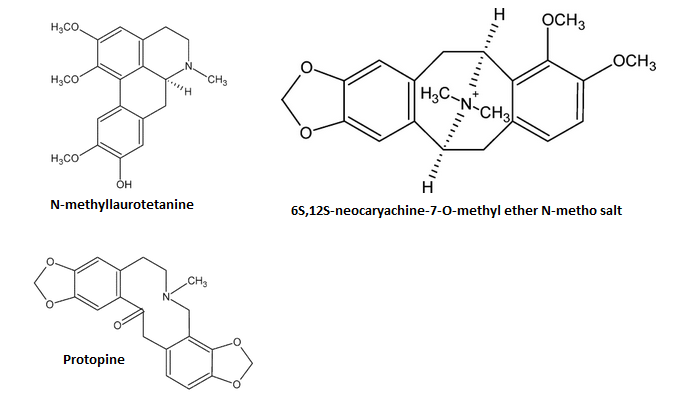California Poppy
California Poppy is an herb that has some bioactive alkaloids which may be nootropic or cognitive enhancing in nature; It is currently in the exploratory stages of research.
California Poppy is most often used for
Last Updated:September 28, 2022
1.
Sources and Composition
California Poppy is a herb with the taxonomical designation of eschscholzia californica (genus and species, respectively) and is within the family of Papaveraceae.[1] The Californian Poppy is deemed an invasive species in Chile[2] similar to how Japanese Knotweed is also deemened an invasive species but in North America normally grows (and not deemed invasive) throughout California, usually below 5000 feet, and in parts of Oregon and Washington as well as the Mojave Desert where it has the densest population.[3]
1.1
Composition
California Poppy contains:
- Californidine[3]
- Escholtzine[3]
- The pavine alkaloid 6S,12S-neocaryachine-7-O-methyl ether N-metho salt[3]
- N-methyllaurotetanine[3]
- Caryachine and the O-methylcaryachine related structure[3]
- Protopine[3]
- Chelirubine, macarpine and sanguinarine as well as their dihydro- derivatives[4]
- Benzophenanthridine alkaloids (10-hydroxysanguinarine, 12-hydroxychelirubine, 10-hydroxychelerythrine)[4]
- Dihydrobenzophenanthridines 10-hydroxydihydrosanguinarine and 12-hydroxydihydrochelirubine[4]
- Carotenoids (yellow-orange coloration of the petals)[5]

2.
Pharmacology
2.1
Metabolism
One study using rats as a model to study two alkaloids in California Poppy, Californine and Protopine, noted that both alkaloids were subject to metabolism by Catechol-O-Methyltransferase and subsequently conjugated in the urine.[6]
2.2
Enzymatic Interactions
A 70% ethanolic extract (1.82% alkaloids) appears to inhibit CYP3A4 with an IC50 value of 128.6+/-61.8ug/mL, which was thought to be mediated by mostly Escholtzine with an IC50 of 13.4 ± 4.7μM.[3] Californidine and Protopine were not significantly active (over 80uM).[3]
An ethanolic extract in general appears to possess MAO-B inhibitory potential.[7]
3.
Neurology
3.1
Anxiety
One study combining California Poppy with Crataegus oxyacantha in 264 patients with diagnosed General Anxiety Disorder of mild to moderate intensity over a period of three months given combination therapy (75mg dry hydroalcoholic extract of CO, 20mg dry water extract of CP; 75mg elemental Magnesium) or placebo showed statistically significant benefits associated with all parameters of Anxiety (assessed by Hamilton Anxiety Scores) on day 14, 60, and 90 with a dip at day 30 where placebo was effective enough to make no significant difference; side effects did not differ between groups.[8]
Animal studies on anxiety with California Poppy (aqueous extract) show benefit with 25mg/kg daily.[9] 200mg/kg of a 60% aqueous extract (injections) appears to have anxiolytic properties in animals as well with nonsignificantly different potency when compared to 2mg/kg Midozolam (although it trended to be weaker).[10]
Appears to have moderate to weak anti-anxiety actions, but insufficient human testing (only current study is confounded with the inclusion of another herb)
3.2
Sedation
100mg/kg of the aqueous extract of California Poppy in rats appears to accelerate the induction of sleep, which demonstrates sedative actions.[9] These sedatory actions (in another test using 200mg/kg injections) were partially antagoniszed by flumazenil by about half, a benzodiazepine and GABA antagonist.[10]
In Anticonvulsant and myorelaxant tests, the plant extract was ineffective at both up to 400mg/kg while reference benzodiazepines were effective.[10] California Poppy also failed to protect against Amphetamine-induced death despite benzodiazepines being effective.[10]
3.3
Acetylcholine
An anticholinergic test with up to 400mg/kg of a 60% water extract of California Poppy failed to exert anticholinergic effects.[10] These lack of effects may be due to using a water extract in this study, as an ethanolic extract of the roots and aerial parts (leaves) has two alkaloid components (reticuline 9 and 14) that inhibit acetylcholinesterase enzymes; no effect was noted on butyrylcholinesterase.[11]
3.4
Serotonin
A 70% ethanolic extract of California Poppy (1.82% alkaloids) was able to bind to both 5-HT1A and 5-HT7 receptors in vitro at 100mcg/mL.[3] Specifically, when the 70% ethanolic extract was incubated at 9mcg/mL, it showed inhibition of 64 +/-4% of 5-HT1A receptors and inhibition of 76 +/-1% of 5-HT7 receptors. Binding on the 5-HT1A was mostly due to N-methyllaurotetanine since it alone showed an EC50 of 160+/-10nM and a Ki of 0.085 ± 0.001uM in preventing binding of 8-OH-DPAT to this receptor.[3]
Highly potent interactions at the level of the receptor with the ethanolic extract, but it is not known whether this is an agonist (activator) or antagonist (inactivator), or whether it is biologically relevant
3.5
Dopamine
California Poppy appears to inhibit Dopamine-B-Hydroxylase.[7]
3.6
Adrenergic
In human recombinant Sf9 cells, 9mcg/mL of the 70% ethanolic extract showed inhibition of 30+/-7% of Alpha-2-Adrenergic receptors; less potent than the active control of yohimbine with an EC50 of 8.5nM.[3]
Some beta-blocking potential exists, with this extract inhibiting 32 +/-3% of binding to Beta-1-Adrenergic receptors, but underperformed relative to the active control of Propanolol (1.8nM EC50).[3]
3.8
Adenosine
Some inhibitory potential was noted against the Adenosine A1 receptor in vitro with 70% ethanolic extract of California Poppy, inhibiting 21 +/-5% of receptor binding; this was weaker than the active control Dipropylcyclopentylxanthine (1200nM EC50).[3]
3.9
Cannabinoids
Californian poppy, at 9mcg/mL (a concentration seen as active) of the 70% ethanolic extract failed to show binding to the Cannabinoid CB1 receptor.[3]





